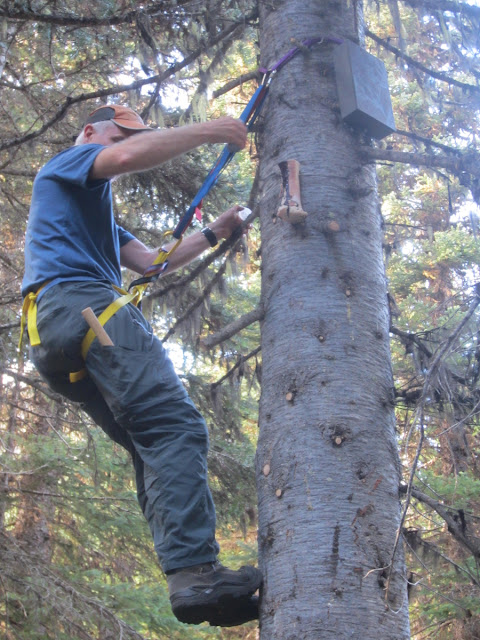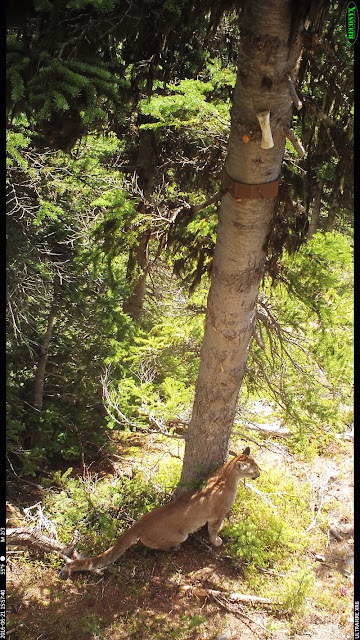Posted by: Gigi Allianic, Communications
As part of a Woodland Park Zoo wildlife study, remote cameras and new, innovative scent lure dispensers—created by the zoo, Idaho Fish and Game, and Microsoft Research and installed last winter in Washington’s Cascade Mountains—have successfully captured images of wolverines, a carnivore rarely seen in the wild.
Research scientists deploy motion sensor remote cameras and odorous scent attractants to capture images of elusive species such as wolverines, lynx, fishers, cougars, grizzly bears and gray wolves but, in the past, have faced challenges during the winter.
Scents naturally fade and need to be refreshed every few weeks, said Robert Long, PhD, a carnivore research ecologist and a senior conservation fellow in Woodland Park Zoo’s field conservation department. “Deep snow and dangerous avalanche conditions in the Cascades typically make it too risky in backcountry terrain to routinely change out baits or replenish odorous lures,” explained Long. “We needed an electronic device that would predictably dispense a small but regular amount of liquid scent.”
Long teamed up with an Idaho Fish and Game colleague and Mike Sinclair, a Microsoft research engineer, to build the device. Sinclair designed the missing piece—a processor board—that ultimately led to a high-tech dispenser lure capable of dispensing scent all winter long.
Twenty-four new dispensers were deployed in the North Cascades over the 2015-16 winter and were retrieved in early July. Long reports that wolverines were detected at 13 of the 24 stations, with a possibility of four to seven individuals represented. This is an extremely positive result given how widely these individuals roam and the vastness of the survey area. The cameras also lured other animals including Canada lynx, cougars, bears, Pacific martens and at least one gray wolf.
“The new scent dispensers did their job,” said Long. “When used in the winter, or even in the summer, the dispensers dramatically increase the period of time that carnivore survey stations can be left out in the wild. Places too dangerous to access by researchers in the winter can be surveyed and researchers in the summer don’t have to revisit stations every three to four weeks to replenish scent or bait. This amounts to a tremendous savings in resources and increased safety for researchers.”
An upgraded version of the dispenser has been developed and 20 units are being deployed again this winter for testing. Long said the goal is to develop effective, non-invasive survey methods and protocols for wolverines. A version 2.0 dispenser coupled with changes such as rotating the cameras vertically and installing them above the high snow line could potentially result in a very effective survey approach. “This can get us closer to the overarching objective of creating a long-term monitoring program that will contribute to a better understanding of how the species is recovering and how individuals respond to climate change over the long term,” said Long.
Forty dispensers also are being tested at survey stations as part of a much larger wolverine study spanning Washington, Montana, Wyoming and Idaho, which will generate even more test data next spring. The new scent dispensers have potential to help researchers monitor not only wolverines but other animals such as fishers, martens and Canada lynx in hard to reach locations in the winter and other seasons, explained Long.
Under the federal Endangered Species Act, the wolverine is currently being considered for protection as a threatened species. Trapping eliminated the species from Washington, Oregon and California by the mid-1990s and from most or all of its historical range in the contiguous U.S. as well. Today, researchers suspect there could be 20 to 40 wolverines living in the Pacific Northwest, representing the only existing population in the contiguous U.S. outside of the Rocky Mountains. The primary threat facing the North American wolverine is habitat and range loss due to climate warming, although studies are currently examining whether backcountry recreation and human disturbance also are negatively impacting populations.
Long, a carnivore research ecologist, is known for spearheading innovations in non-invasive wildlife research methods and conducts carnivore research in North America. He is currently focused on wolverine research and conservation in Washington state, and is helping to expand Woodland Park Zoo's Living Northwest conservation program which includes the Washington Urban–Wildland Carnivore Project.
 |
| A zoo research camera catches a glimpse of a wolverine checking out the new scent lure. Photo: Woodland Park Zoo. |
As part of a Woodland Park Zoo wildlife study, remote cameras and new, innovative scent lure dispensers—created by the zoo, Idaho Fish and Game, and Microsoft Research and installed last winter in Washington’s Cascade Mountains—have successfully captured images of wolverines, a carnivore rarely seen in the wild.
Research scientists deploy motion sensor remote cameras and odorous scent attractants to capture images of elusive species such as wolverines, lynx, fishers, cougars, grizzly bears and gray wolves but, in the past, have faced challenges during the winter.
Scents naturally fade and need to be refreshed every few weeks, said Robert Long, PhD, a carnivore research ecologist and a senior conservation fellow in Woodland Park Zoo’s field conservation department. “Deep snow and dangerous avalanche conditions in the Cascades typically make it too risky in backcountry terrain to routinely change out baits or replenish odorous lures,” explained Long. “We needed an electronic device that would predictably dispense a small but regular amount of liquid scent.”
 |
| A winter sighting of a wolverine. Photo: Woodland Park Zoo. |
Long teamed up with an Idaho Fish and Game colleague and Mike Sinclair, a Microsoft research engineer, to build the device. Sinclair designed the missing piece—a processor board—that ultimately led to a high-tech dispenser lure capable of dispensing scent all winter long.
 |
| Researcher Robert Long prepares the scent lure. Photo: Woodland Park Zoo. |
 |
| Long installs the lure securely to last through the winter season. Photo: Woodland Park Zoo. |
Twenty-four new dispensers were deployed in the North Cascades over the 2015-16 winter and were retrieved in early July. Long reports that wolverines were detected at 13 of the 24 stations, with a possibility of four to seven individuals represented. This is an extremely positive result given how widely these individuals roam and the vastness of the survey area. The cameras also lured other animals including Canada lynx, cougars, bears, Pacific martens and at least one gray wolf.
 |
| A bear checks out the scent lure. Photo: Woodland Park Zoo. |
 |
| A cougar, too. Photo: Woodland Park Zoo. |
“The new scent dispensers did their job,” said Long. “When used in the winter, or even in the summer, the dispensers dramatically increase the period of time that carnivore survey stations can be left out in the wild. Places too dangerous to access by researchers in the winter can be surveyed and researchers in the summer don’t have to revisit stations every three to four weeks to replenish scent or bait. This amounts to a tremendous savings in resources and increased safety for researchers.”
An upgraded version of the dispenser has been developed and 20 units are being deployed again this winter for testing. Long said the goal is to develop effective, non-invasive survey methods and protocols for wolverines. A version 2.0 dispenser coupled with changes such as rotating the cameras vertically and installing them above the high snow line could potentially result in a very effective survey approach. “This can get us closer to the overarching objective of creating a long-term monitoring program that will contribute to a better understanding of how the species is recovering and how individuals respond to climate change over the long term,” said Long.
 |
| We detected wolverines at 13 of 24 stations. Photo: Woodland Park Zoo. |
Forty dispensers also are being tested at survey stations as part of a much larger wolverine study spanning Washington, Montana, Wyoming and Idaho, which will generate even more test data next spring. The new scent dispensers have potential to help researchers monitor not only wolverines but other animals such as fishers, martens and Canada lynx in hard to reach locations in the winter and other seasons, explained Long.
 |
| The North Cascades terrain. Photo: Woodland Park Zoo. |
Under the federal Endangered Species Act, the wolverine is currently being considered for protection as a threatened species. Trapping eliminated the species from Washington, Oregon and California by the mid-1990s and from most or all of its historical range in the contiguous U.S. as well. Today, researchers suspect there could be 20 to 40 wolverines living in the Pacific Northwest, representing the only existing population in the contiguous U.S. outside of the Rocky Mountains. The primary threat facing the North American wolverine is habitat and range loss due to climate warming, although studies are currently examining whether backcountry recreation and human disturbance also are negatively impacting populations.
Long, a carnivore research ecologist, is known for spearheading innovations in non-invasive wildlife research methods and conducts carnivore research in North America. He is currently focused on wolverine research and conservation in Washington state, and is helping to expand Woodland Park Zoo's Living Northwest conservation program which includes the Washington Urban–Wildland Carnivore Project.
Comments
Post a Comment